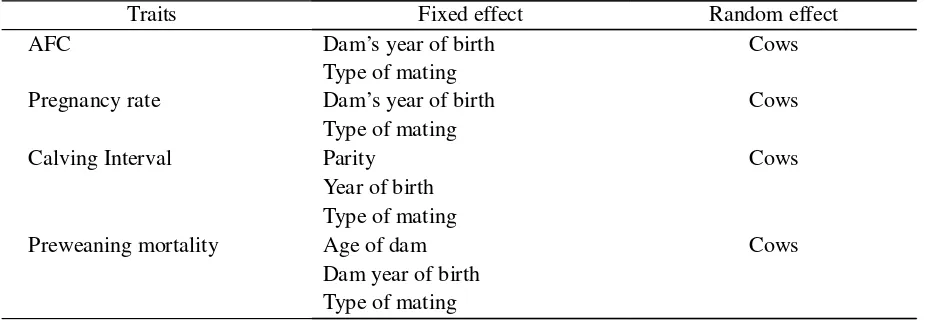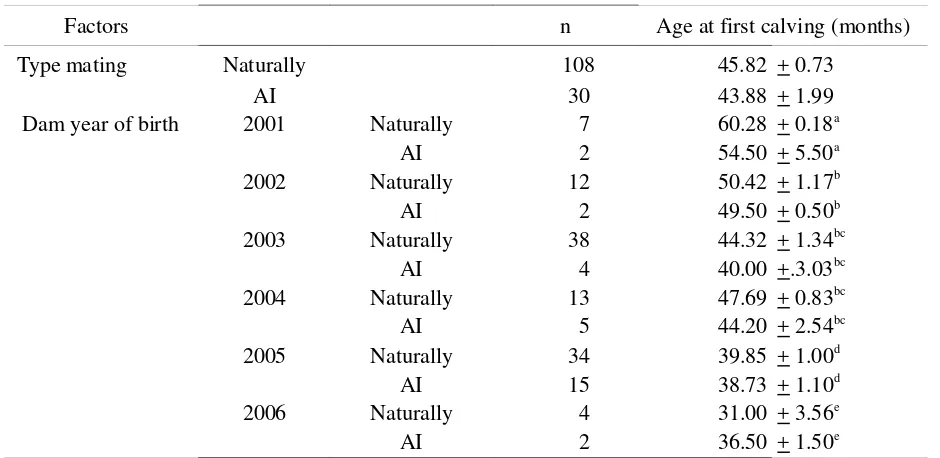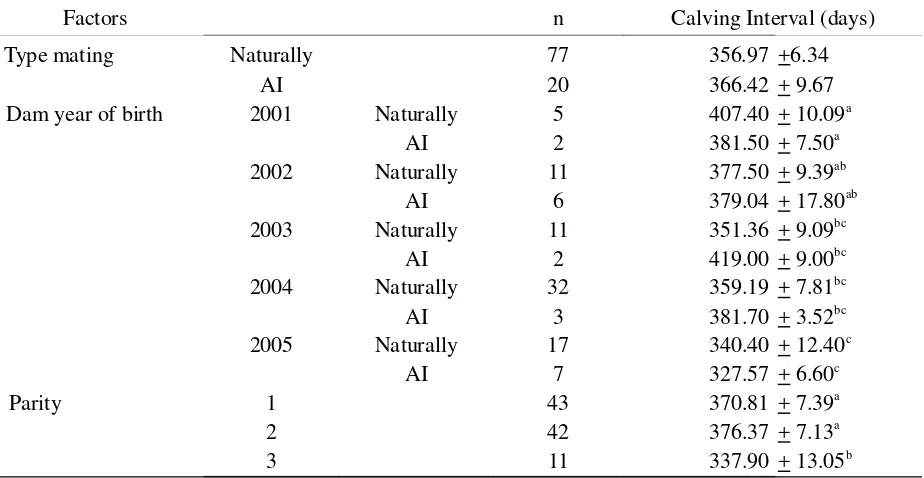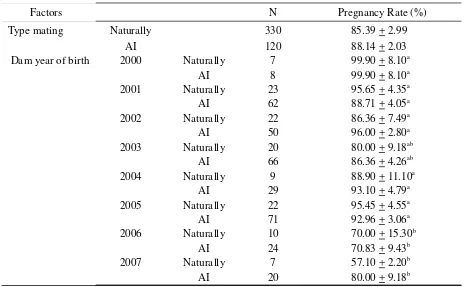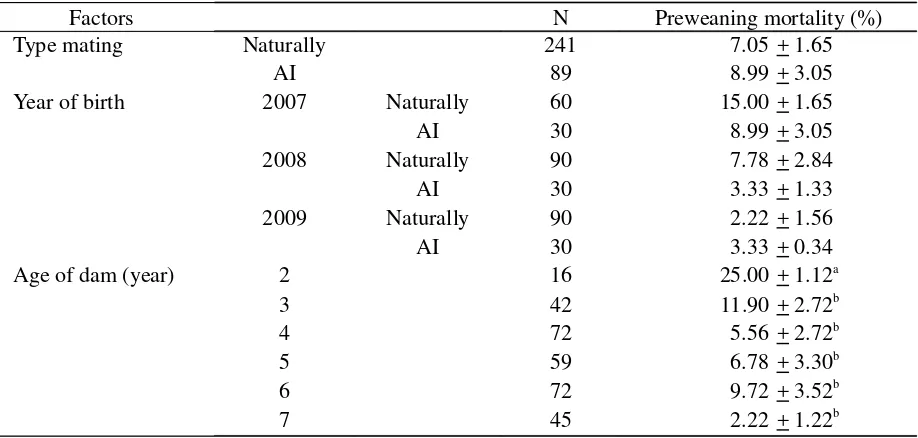NON GENETIC FACTORS EFFECT ON REPRODUCTIVE PERFORMANCE AND
PREWEANING MORTALITY FROM ARTIFICIALLY AND NATURALLY
BRED IN BALI CATTLE
A. Gunawan1, R. Sari1
, Y. Parwoto2
and M. J. Uddin3 1
Faculty of Animal Science, Bogor Agricultural University, Jl. Agatis, Darmaga Campus, Bogor 16680 - Indonesia 2
Breeding Centre of Bali Cattle, Jl. Gurita III Pegok, Denpasar, Bali - Indonesia 3
Department of Medicine, Faculty of Veterinary Science, Bangladesh Agricultural University, Mymensingh-2202 - Bangladesh
Corresponding E-mail:aagun4780@yahoo.com
Received January 10, 2011; Accepted May 03, 2011
ABSTRACT
The aim of this study was to evaluate effect of non genetic factors on reproductive performance of Bali cattle. Data on reproduction performance were collected from Breeding Centre of Bali Cattle in Denpasar-Bali. Reproductive traits studied were age at first calving (AFC), calving interval (CI) and pregnancy rate (PR). To observe the effect of non genetic factors on the reproductive traits, a mixed model was used because all of the traits studied were measured repeatedly in individuals. The overall means for AFC, CI, PR and preweaning mortality were 43.86±0.70 months, 360.93±4.47 days, 88.44±1.91% and 7.58±1.07%, respectively. The results showed that AFC and PR were significantly (P<0.01) influenced by dam year of birth but mating system had no significant (P>0.05) effect. With regard to CI, dam year of birth and parity affected CI while mating system had no significantly affect (P>0.05) on CI. The preweaning mortality was only affected by the age of dam significantly (P<0.01). The average of reproductive performance and preweaning mortality in Bali Cattle were not depended remarkably on the mating system being practiced. It might be concluded that an improvement in Bali cattle reproductive traits is possible through improving management systems and utilisation of controlled breeding techniques.
Keywords: age at first calving, Bali cattle, calving interval, pregnancy rate, preweaning mortality
INTRODUCTION
Bali cattle are one of several Indonesian native cattle that plays major role for beef production. The population of Bali cattle in Indonesia were recorded 3.271.000 in 2010 of which 20% were concentrated in Bali province (Direktorat Jenderal Peternakan, 2010). Comparing toother breeds, Bali cattle have better adaptation especially in marginal environment (Zulkharniem et al., 2010), have high meat quality and low fat percentage (Bugiwati, 2007). Bali cattle are considered as more fertile and have better reproductive performance compared to other breeds of cattle. Their fertility reached around 80-82% and have high heterosis effect in crossbred (Noor et al., 2001). However, calf mortality in Bali cattle is high, reaching 30% (Toelihere, 2002). On the other hand, genetic improvements of reproductive traits are considered to be limited because of low
heritability. Reproductive traits heritability range between 0.03 and 0.05 (Freeman, 1984). Lower heritability is partly affected by the existence of a very important environmental influence on these traits (Goyache and Gutierrez, 2001). To improve the reproduction traits of Bali cattle through selection programs, it is necessary to know the environment factor or non genetic factor that affect the reproductive of Bali cattle. Information of reproductive performance in Indonesian local cattle such as Bali cattle is very rare. Previous study reported that the average of service per conception in Bali cattle was about 1.8-2.0 and the calving rate was 64-78% (Bamualim and Wirdahayati, 2002). Therefore, it become highly imperative to study the influence of non genetic affect on the trait of economic interest such as reproductive performance
and to examine the importance of non genetic factor affecting them.
MATERIALS AND METHODS
The data used in this study were collected from Breeding Centre of Bali cattle in Bali province from September, 2005 to September, 2008. A total of 465 cattle were used in this study consisting of 15 bulls and 450 cows with the average body weight of 180 kg or have reached sexual maturity. Reproductive management primarily involved artificial insemination (AI) using either frozen semen or natural breeding using purebred bulls. The data structure is presented in Table 1.
Data classification
Seasons were not included in this experiment as non genetic factor because breeding centre had breeding season that regularity as mating season in December. Age of dam, sex of calf and parity were reported as non genetic factor (Kempt et al., 1984). In this study, non genetic factor were parity, dam’s year of birth, age of dam and type of
mating. Data analyses
To assess the effect of non-genetic factor on reproductive traits, least squares analysis of variance were performed using the MIXED model procedure of SAS Version 9.2 (SAS, 2000) since all of the traits studied were measured repeatedly in individuals. Mixed models contained both fixed effect and random effects are presented in Table 2. Model used to analyze age at first calving was used as random effect of cow, whereas dam year of birth (6 levels: 2001-2006) and type of mating (2 levels: naturally and AI) were used as fixed effects in the model. In the case of pregnancy rate (PR), cows were used as random effect and dam’s year of birth (8 levels: 2000-2007) and type of mating were used as fixed effect. The model for calving interval included cows as random effect and parity (3 levels: 1-3), year of birth (5 level: 2000-2005) and type of mating were considered fixed effect. Preweaning mortality were used as random effect of cows and age of dam (5 levels: 2-7 year), dam year of birth (3 levels: 2007-2009) and type of mating (2 level:
Table 1. Reproductive Performance of Bali Cattle
Traits No. of
Records Mean
Standar Deviation
Coefficient
of Variation Min Max
Age at first calving (months) 138 43.86 0.70 18.81 25.00 100.00
Calving interval (days) 96 360.93 4.47 12.13 329.00 363.50
Pregnancy rate (%) 450 88.44 1.51 36.19 0.00 100.00
Preweaning mortality (%) 330 7.58 1.46 34.98 0.00 100.00
Table 2. Fixed and Random Effect Used for Data Analysis
Traits Fixed effect Random effect
AFC Dam’s year of birth Cows
Type of mating
Pregnancy rate Dam’s year of birth Cows
Type of mating
Calving Interval Parity Cows
Year of birth Type of mating
Preweaning mortality Age of dam Cows
naturally and AI) were used as fixed effect. RESULTS AND DISCUSSION
Age at first calving
Age at first calving was significantly affected by dam’s year of birth (2001-2006). The female calves born during 2004 to 2006 year gave birth earlier than those born in 2001 to 2003 (Table 3). This results is in agreement with the results of Javed et al. (2000) who found that the dam’s year of birth had significant effect on age at first calving in Sahiwal cows. The significant effect of dam’s year of birth could be attributed to variability in management and climate especially between different years. It could be speculated that the age first at calving from 2004 to 2006 were earlier than 2001 to 2003 might be due to the increasing of supplementation and some veterinary inputs in breeding centre. The feed sources for Bali cattle were extremely variable: grazed forage from grasslands and estate cropping, cut and carry forages from on and off the farm, and crop residues. Without substantial additions to the diet in the form of mineral, protein and energy supplements, both reproduction and animal production were invariably poor.
The type of mating had no influence on AFC. It means that artificially inseminated cows had no differential effect on the average of AFC
than naturally bred cow (Table 3). This result is in contrast with the previous study by Mwatawala and Kifaro (2009) who reported that artificially inseminated cows were older at calving than naturally bred cow by 3.9 month. This study showed that naturally bred cows were older at calving by 1.9 month than those born from artificially inseminated cow. The similar average of age at first calving between artificially and naturally bred cows could be as a result of high conception rate in artificially inseminated bred cows. No different calving of artificially bred cows compared to those mated by bulls was probably as a result of good management for detection reproduction aspect in breeding centre.
The mean of age at first calving of the 138 cows examined was 43.86+ 0.70 months. Alberro (1983) reported that age at first calving for Bos indicus in the tropics was about 35.1-53 months. This study was also lower than the 45 to 53 months reported in other studies (Mukasa-Mugerwa et al. 1989; Haile-Mariam et al. 1993)
for different Bos indicus cattle. Nevertheless, AFC in Bali cattle is higher than those obtained by Shamsudin et al. (2006) that reported the age at first calving in South Asian cattle were varied from 33 to 40 months. The age at first calving determines the attainment of physical and sexual maturity (Kuthi et al. 2007). The decreasing value observed for AFC from 2001 to 2006 in Breeding Centre indicated an improvement in the genetic
Table. 3. Least Square Means and Standard Error (SE) for Age at First Calving (Months)
Factors n Age at first calving (months)
Type mating Naturally 108 45.82 + 0.73
AI 30 43.88 + 1.99
Dam year of birth 2001 Naturally 7 60.28 + 0.18a
AI 2 54.50 + 5.50a
2002 Naturally 12 50.42 + 1.17b
AI 2 49.50 + 0.50b
2003 Naturally 38 44.32 + 1.34bc
AI 4 40.00 +.3.03bc
2004 Naturally 13 47.69 + 0.83bc
AI 5 44.20 + 2.54bc
2005 Naturally 34 39.85 + 1.00d
AI 15 38.73 + 1.10d
2006 Naturally 4 31.00 + 3.56e
AI 2 36.50 + 1.50e
merit of this trait including managemental practices and nutritional management. Nutritional management strategies can reduce the age at puberty. Age of puberty in breeding centre is generally reached by both males and females between 12 and 24 months of age, at weights from 100–150 kg.
Calving Interval
Calving interval (CI) of cows from 2001 to 2005, based on 96 observations averaged 360.93 ± 4.47 days. The average calving interval in tropical cattle ranged from 365-536 days among the indigenous and crossbred cattle (Kamal, 2010). This result reflects the management adopted in the centre, which recommends the mating of cows at about 3 months post partum. Calving interval was significantly (P<0.01) affected by year of birth and parity but not by type of mating (Table 4). The cows giving birth during 2005 had calving intervals 2 months shorter than those of cows calveing in 2001. A shorter calving interval will lead to a higher calving rate in the following year. It may also lead to calves being born earlier in the calving period, when nutrition is better for the dam. The eastern parts including Bali in particular, is insufficiency of both quality and quantity of available feed for the whole year. The quality and quantity of forage available is not similar in every year. In the rainy season, individual growth is good because the quality and
quantity of forage are abundant. Meanwhile, In the dry season feed availability becomes a serious problem that is very disturbing livestock productivity (Tahuk and Dethan, 2010). All these factors therefore are likely to have a profound effect on the reproductive performance of Bali cattle.
The significant effect of parity on reproductive performance especially in case of calving interval may be due to the changes in managerial systems and environmental conditions among parities in breeding centre. This result is in agreement with Bulman and Wood (1980) who reported that the incidence of silent oestrus was the highest in the primiparous cows and decreased with the advance in parity number. Oestrus is primarily a nocturnal event in Bali cattle, with an average duration of 18–19 hours (Fordyce et al., 2002). The average length of the oestrus cycle is 21 days, with some evidence that is shorter when nutrition is more poor.
Cow bred by artificial insemination had no differences for the average of calving interval when compared to naturally bred cow. This result is in contrast with the previous study by Mwatawala and Kifaro (2009) who reported tht naturally bred cows tended to calve again about 50 days earlier than artificially bred cows. However, this study showed that naturally bred cows tend to calve again about 10 days earlier than artificially bred. Haile-Mariam et al. (1993)
Table 4. Least Square Means and Standard Error (SE) for Calving Interval (days)
Factors n Calving Interval (days)
Type mating Naturally 77 356.97 +6.34
AI 20 366.42 + 9.67
Dam year of birth 2001 Naturally 5 407.40 + 10.09a
AI 2 381.50 + 7.50a
2002 Naturally 11 377.50 + 9.39ab
AI 6 379.04 + 17.80ab
2003 Naturally 11 351.36 + 9.09bc
AI 2 419.00 + 9.00bc
2004 Naturally 32 359.19 + 7.81bc
AI 3 381.70 + 3.52bc
2005 Naturally 17 340.40 + 12.40c
AI 7 327.57 + 6.60c
Parity 1 43 370.81 + 7.39a
2 42 376.37 + 7.13a
3 11 337.90 + 13.05b
also observed the same result that Boran cows naturally mated to Boran bulls had shorter CI than Boran cows artificially inseminated with Friesian semen by 50 and 87 days, respectively. The same reasons discussed above (under AFC) on superiority of naturally bred heifers over artificially bred cows could explain the similar phenomenon in cows. Haile-Mariam et al. (1993) reported the mean CI of approximately 464. Assuming a gestation period of 280 days, it means that the days open was averaged about 184 days or approximately 6 months. A multitude reasons could account for such a long calving to conception period including the ranch type of management, nutrition, bulls used and competence levels in conducting artificial insemination (Mwatawala and Kifaro, 2009) Pregnancy rate
The average pregnancy rate (PR) in this study was 88.44 ± 1.51%. Highly significant (P < 0.01) influences of dam’s year of birth on pregnancy rate was detected, while the type mating had no significant effect on pregnancy rate (Table 5).
The range of pregnancy during 2000-2005 and 2006-2007 were 84.14 to 99.90% and 70.02
to 73.41%, respectively. The average number of cows pregnant were higher in cows born between 2000 to 2005 year than those in 2006 to 2007. Borman et al. (2006) reported that cows pregnancy rate varied from 75 to 95% between herds and from 65 to 100% between sires, with an overall pregnancy rate of 93%. The lower pregnancy rate in this study occurred in case of the first calf heifers on 2006 and 2007 year. This result is in agreement with the previous study by Dearborn (1973) who reported the lower pregnancy rate noted in years when a larger percentage were the first calf heifers.
The fluctuation of values observed for pregnancy rate from 2000 to 2007 indicated that environment may play a great role in the ability of a cow to become pregnant in the breeding centre. Oestrus is primarily a nocturnal event in Bali cattle (Fordyce et al., 2002). Expertise of the oestrus detector and the AI technician could influence overall pregnancy rate. In the breeding centre mating is dependent on bull and female condition, nutritional status and bull-to-female ratio. The average percentage of pregnancy rate in Bali cattle was not depend largely on the mating system being practiced. However, in case of uncontrolled natural breeding, the pregnancy rate
Table 5. Least Square Means and Standard Error (SE) for Pregnancy Rate (%)
Factors N Pregnancy Rate (%)
Type mating Naturally 330 85.39 + 2.99
AI 120 88.14 + 2.03
Dam year of birth 2000 Naturally 7 99.90 + 8.10a
AI 8 99.90 + 8.10a
2001 Naturally 23 95.65 + 4.35a
AI 62 88.71 + 4.05a
2002 Naturally 22 86.36 + 7.49a
AI 50 96.00 + 2.80a
2003 Naturally 20 80.00 + 9.18ab
AI 66 86.36 + 4.26ab
2004 Naturally 9 88.90 + 11.10a
AI 29 93.10 + 4.79a
2005 Naturally 22 95.45 + 4.55a
AI 71 92.96 + 3.06a
2006 Naturally 10 70.00 + 15.30b
AI 24 70.83 + 9.43b
2007 Naturally 7 57.10 + 2.20b
AI 20 80.00 + 9.18b
was always not lower than that of artificial insemination. In the Breeding Centre Bali Cattle (BPTU), cows those were allocated to bulls for natural mating produced the same services to conceive with natural insemination.
Preweaning mortality
The overall means for preweaning mortality were 7.58 ± 1.46 %. Only age of dam were highly significantly (P < 0.01) influenced preweaning mortality, while year and the type of mating did not show any significant (P > 0.05) effect on preweaning mortality (Table 6).
The average number of preweaning mortality were not significant (P>0.05) from calves born between 2007 to 2009. The average preweaning mortality on 2007, 2008 and 2009 were 15.56; 6.67 and 2.50%, respectively. It has been suggested that the preweaning mortality rates of at least 30% is normal for cattle in the tropics (Holroyd et al., 1993). This result is in contrast with the previous study by Riley et al. (2004) who reported that the year had effect on preweaning mortality in Brahman calves. Morever, the significant effect of year could be attributed to variability in management and climate especially between different years (Riley et al., 2004). Higher levels of calf mortality in the breeding centre occur in newborn calves and in absent of proper mothering and management supported. Furthermore, the majority of calf mortality in Bali cattle presumed to be caused in the dry season
when feed resources are low in quality and quantity, leading to milk production as low as 1.5 L per day (Belli, 2002).
Calf calved by 2 years old young cows had greater preweaning mortality than that calved after 2 year of age. The greater preweaning mortality in calf calved by younger mother are seem to be consistent with other age associated with lower of cow performance (Riley et al., 2004). Hansen et al. (2003) reported tht the higher postnatal mortality of Danish Holstein calves born to young cows (23 month of age or less) than that of calves born to older cows. Cloete and Scholtz (1998) reported higher desertions, higher frequency of avoidance, and less cooperation with their lambs’ first attempts to nurse in young (first parity) vs. older ewes. One of the most important age-dependent factors affecting calf mortality (and possibly birth vigor) was the structure and quality of the dam’s udder (Edwards, 1982). Cows in their prime production years may give birth to a physiologically more competent calf and/or be maternally more attentive, and therefore be more successful at raising calves to weaning. Maternal inclination of cows may be substandard relative to cows and therefore negatively affect calf birth vigor and preweaning mortality. Abnormal maternal behavior, especially among heifers was associated with the increase time from birth to first nursing (Rowan, 1992). Another potential source of age-related stress (especially for heifers and aged cows) may be associated with the effort
Table 6. Least Square Means with Their Standard Error (SE) for Preweaning Mortaility (%)
Factors N Preweaning mortality (%)
Type mating Naturally 241 7.05 + 1.65
AI 89 8.99 + 3.05
Year of birth 2007 Naturally 60 15.00 + 1.65
AI 30 8.99 + 3.05
2008 Naturally 90 7.78 + 2.84
AI 30 3.33 + 1.33
2009 Naturally 90 2.22 + 1.56
AI 30 3.33 + 0.34
Age of dam (year) 2 16 25.00 + 1.12a
3 42 11.90 + 2.72b
4 72 5.56 + 2.72b
5 59 6.78 + 3.30b
6 72 9.72 + 3.52b
7 45 2.22 + 1.22b
to match nutrient intake with lactation and body maintenance requirements (Riley et al., 2004).
The average percentage of preweaning mortality in Bali cattle was not depended largely on the mating system being practiced. It was not always lower in case of artificial insemination than that of uncontrolled natural breeding. Although preweaning mortality has been pointed out as a problem inherent to Bos sondaicus cattle such as Bali cattle. However, preweaning mortality has also been reported in Angus, Hereford, Chianina, Jersey, Holstein, Limousine, and Brown Swiss (Landaeta et al., 1997). Recently, peri-natal calf mortality in F1 Red and Grey Brahman x Hereford calves was reported to occur without a relationship to dystocia or any fashionable use of bulls and breeds (Landaeta et al., 1997). Poor suckling ability of weak calves may result in inadequate colostrum intake. Thus, the most frequent causes for calf losses were poor immune-competence, subsequent illness (gastro-respiratory diseases), starvation, and other intensive conditions in the local region. Therefore, an improvement of Bali cattle reproductive traits is possible both through improving management systems and utilisation of controlled breeding techniques.
REFERENCES
Alberro M. 1983. Comparative performance of F1 Friesian x zebu heifers in Ethiopia. Anim. Strategies to Improve Bali Cattle in Eastern Indonesia, Denpasar, Bali, February 4-7,
2002. Page 17-22
Belli, H. L. L. 2002. Supplementaion to improve the performance of grazing Bali cows (Biboss banteng Wagner). PhD Thesis. University of Gottingen, Goettingen.
Bormann, J. M., L. R. Totir, S. D. Kachman, R. L. Fernando. and D. E. Wilson. 2006 Pregnancy rate and first-service conception rate in Angus heifers. J. Anim. Sci. 84:2022-2025 Bugiwati, S. R. A. 2007. Body dimension growth
of calf bull in Bone and Baru District, South Sulawesi. J. Sains and Tekno. 7:103-108 Bulman, D. C. and P. D. P. Wood.1980. Abnormal
patterns of ovarian activity in dairy cows and their relationships with reproductive performance. Anim. Prod. 30: 177-188 Cloete, S. W. P., and A. J. Scholtz. 1998. Lamb
survival in relation to lambing and neonatal behaviour in medium wool Merino lines divergently selected for multiple rearing ability Aust. J. Exp. Agric. 38:801–811 Deaborn, D.D., R.M. Koch, L.V. Cundiff, K.E.
Gregory, and G.E. Dickerson. 1973. An analysis of reproductive traits in beef cattle. J. Anim. Sci. 36:1032-1040
Direktorat Jenderal Peternakan. 2010. Statistik Peternakan 2010. Direktorat Jenderal Peternakan Departemen Pertanian RI, Jakarta
Edwards, S. A. 1982. Factors affecting the time to first suckling in dairy calves. Anim. Prod. 34:339–346
Fordyce, G., T. Panjaitan., Muzani. and D. Poppi. 2002. Nutrition and management strategies to improve Bali cattle productivity in Nusa Tenggara. Proc. ACIAR Workshop on Strategies to Improve Bali Cattle in Eastern Indonesia, Denpasar, Bali, February 4-7, 2002. P.23-28
Freeman, A.E., 1984. Secondary traits: Sire valuation and the reproductive complex. J. Dairy Sci. 67:449-458
Goyache, F. and J. P Gutierrez. 2001. Heritability of reproductive traits in Asturiana de los Valles beef cattle breed. Arch. Tierz. 44:489-496
Haile-Mariam, M., K. Banjaw, T. Gebre-Meskel and H. Ketema. 1993. Productivity of Boran cattle and their Friesian crosses at Abernossa ranch, Rift Valley of Ethiopia. I. Reproductive performance and pre-weaning mortality. Trop. Anim. Health Prod. 25:239- 248
and L. G. Christiansen. 2003. Genetic parameters of postnatal mortality in Danish Holstein calves. J. Dairy Sci. 86:1807-1817. Holroyd, R.G., K.W. Entwistle. and R.K.
Shepherd. 1993. Effects on reproduction of oestrus cycle variations, rectal temperatures and liveweights in mated Brahman cross heifers. Theriogenology. 40:453–464.
Javed, K., G. Mohiuddin and M. Abdullah. 2000. Some environmental effects on reproductive traits of Sahiwal cattle. J. Anim. Plant Sci. 10(4):109-112
Kamal, M.M. 2010. A review on cattle reproduction in Bangladesh. Inter J.Dairy Sci. 5:245-252
Kemp, R.A., L.A. Schaffer and J. Wilson, 1984. Effect of season of lambing on of dam, age of dam and sex of calf effects in Canadian Simmental. Canadian J. Anim. Sci. 64:1-8 Kuthi, Z.H., K. Javed and N. Ahmad. 2007.
Reproductive performance of indigenous cows of Azad Kashmir. J. Anim. Plant Sci. 17: 47-51
Landaeta, A., P.J. Chenoweth, O. Verde, J. M. Ferrer, M. Baroza, N. Soto and T. Moreno. 1997. Neonatal weakness and its sequel in tropical crossbred calves. Arch. Latinoam. Prod. Anim. 5 (Suppl.1):500-502
Mukasa-Mugerwa E., E. Bekele and T. Tessema. 1989. Type and productivity of indigenous cattle in Central Ethiopia. Trop. Anim. Health Prod. 21:120
Mwatawala, H.W and G.C Kifaro. 2009. Reproductive performance of artificially and naturally bred Boran heifers and cows under ranch conditions in Tanzania. J. Anim. Plant Sci. 4:267-275
Noor, R. R., A. Farajallah and M. Karmita. 2001. The purity test of Bali cattle by haemoglobin analysis using the isoelectric focusing method. Hayati. 8:107–111
Rea, D.E., J.W. Tyler, D.D. Hancok, T.E. Besser, L. Wilson, D.S. Krytemberg and S.G. Sanders. 1996. Prediction of calf mortality by use of test for passive transfer of colostral immunoglobin. JAVMA 208:2047-2049 Riley, D.G., C. C. Chase Jr, T. A. Olson, S. W.
Coleman, and A. C. Hammond. 2004. Genetic and nongenetic influences on vigor at birth and preweaning mortality of purebred and high percentage Brahman calves. J. Anim. Sci. 82:1581-1588
Rowan, T. G. 1992. Thermoregulation in neonatal ruminants. In Neonatal Survival and Growth (M. A. Varley, P. E. V. Williams, and T. L. J. Lawrence, eds). Occasional Publ. Edinburgh, U.K. Page13–24
SAS. 2000: Statistical Analysis System (SAS User’s Guide), Version 8.1. Statistical Analysis System Institute, Inc., Cary, N.C. Shamsuddin, M., M.M.U. Bhuiyan, P.K. Cnada,
M.G.S. Alam and G. Galoway. 2006. Radioimmunoassay of milk progesterone as a tool for fertility control in smallholder dairy farms. Trop. Anim. Health Prod. 38:85-92
Tahuk, P. K. and A. A. Dethan. 2010. Performance of Bali bull in greenlot fattening by farmers when rainy season in Timor island. J. Indonesian Trop. Anim. Agric. 35(4):257-261
Toliehere, M.R. 2002. Increasing the success rate and adoption of artificial insemination for genetic improvement of Bali cattle. Proc. ACIAR Workshop on Strategies to Improve Bali Cattle in Eastern Indonesia, Denpasar, Bali, February 4-7, 2002. Page 48-53
